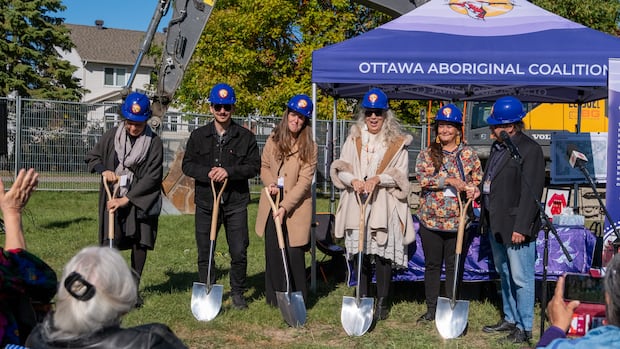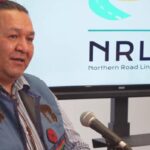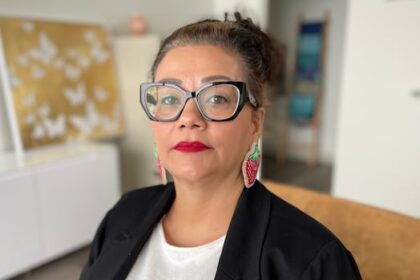North·NewDozens gathered around an empty plot of land in Ottawa’s south end on Thursday afternoon to celebrate what it will soon become – a home for Inuit women and children fleeing violence in Canada’s capital.Organizers say 30-bed shelter to be first of its kind south of Inuit Nunangat Anchal Sharma · CBC News · Posted: Oct 17, 2025 1:32 PM EDT | Last Updated: 1 hour agoCommunity leaders celebrated the future opening of a shelter for Inuit women at a ground cleansing ceremony in Ottawa’s Hunt Club neighbourhood. (Jacob Taillefer Racine/Radio-Canada)Dozens gathered around an empty plot of land in Ottawa’s south end on Thursday afternoon to celebrate what the site will soon become – a home for Inuit women and children fleeing violence in Canada’s capital. “This space that we are standing on is going to save Inuit lives,” said Stephanie Mikki Adams, co-chair of the Ottawa Aboriginal Coalition (OAC). The organization spearheaded the project two years ago, and in April secured $6.4 million in funding from the federal Indigenous Shelter and Transitional Housing Initiative to cover construction costs. Adams says this will be the first shelter of its kind south of Inuit Nunangat, with programming and services rooted in the values of Inuit Qaujimajatuqangit, or traditional Inuit knowledge. “We want to ensure that when Inuit women come to this … shelter that they’re surrounded by the beauty of our culture,” she said. Responding to an ‘urgent need’ While there are Indigenous shelters in Ottawa, including Minwaashin Lodge for First Nations, Inuit and Métis women, organizers say demand for temporary housing far exceeds capacity. “They’re turning away 300 Indigenous women a year and at least 30 per cent are Inuit,” said Joan Riggs, a facilitator with the OAC. WATCH | Ottawa Aboriginal Coalition breaks ground on new Inuit women’s shelter:Community leaders cleanse, break ground at future site of Inuit women’s shelterThe future shelter in Hunt Club Park will have 30 beds for Inuit women and children fleeing domestic and intimate partner violence.Riggs adds that Ottawa has the largest Inuit population outside of Nunavut. With the community continuing to grow, she says there’s an “urgent need” in the city for housing options designed for Inuit women escaping abuse. Riggs said the coalition met with Inuit women who have used the city’s shelters to determine how best to meet their needs. Leonie Kunuk, who has lived in Ottawa for 30 years and says she’s familiar with the city’s shelter system, appreciated being consulted. “Inuit women have specific needs that are quite different from white women and First Nations women’s needs,” she explained. Leonie Kunuk is looking forward to having a shelter in the city specifically for Inuit women. (Jacob Taillefer Racine/Radio-Canada)Kunuk said she’s looking forward to having a safe space to practice sewing, eating country food and participating in cultural activities like drum making. “For Inuit women to be able to have a place away from abuse and into a safe place here will be a great opportunity,” she said. Some in community express concernsWhile organizers say response from the community has been overwhelmingly positive, some residents of Ottawa’s Hunt Club neighbourhood have shared apprehension over the shelter being built in their community. Gloucester-Southgate Coun. Jessica Bradley says some residents in her ward have expressed concerns over losing the greenspace the shelter will be built on, while others were worried about living next to ongoing construction. Organizers say the design of the two and a half story building which will have 13 units and 30 beds was informed by consultations with Inuit women in the community who have relied on shelters in the past. (Courtesy of Jessica Bradley)”Change is difficult for any community,” Bradley acknowledged. “But if you think of the women and children who are coming here and the upheaval that they’ve had to go through, I think that we can put up with a little bit of change. ” Bradley adds the neighbourhood is a great place for families and she hopes the women who use the shelter will be welcomed into the community when the time comes. “This space is really going to be a place of hope and recovery and safety,” she said. The future shelter will be two and a half stories high, with 13 units and 30 beds. Future operational costs will be covered by Indigenous Services Canada. Construction will begin in the late fall, with plans to open the shelter in early 2027. ABOUT THE AUTHORAnchal Sharma is a journalist at CBC Ottawa. Send her an email at anchal.sharma@cbc.ca
Tuesday, 2 Dec 2025
Canada – The Illusion
Search
Have an existing account?
Sign In
© 2022 Foxiz News Network. Ruby Design Company. All Rights Reserved.
You May also Like
- More News:
- history
- Standing Bear Network
- John Gonzalez
- ᐊᔭᐦᑊ ayahp — It happened
- Creation
- Beneath the Water
- Olympic gold medal
- Jim Thorpe
- type O blood
- the bringer of life
- Raven
- Wás’agi
- NoiseCat
- 'Sugarcane'
- The rivers still sing
- ᑲᓂᐸᐏᐟ ᒪᐢᑿ
- ᐅᑳᐤ okâw — We remember
- ᐊᓂᓈᐯᐃᐧᐣ aninâpêwin — Truth
- This is what it means to be human.
- Nokoma












